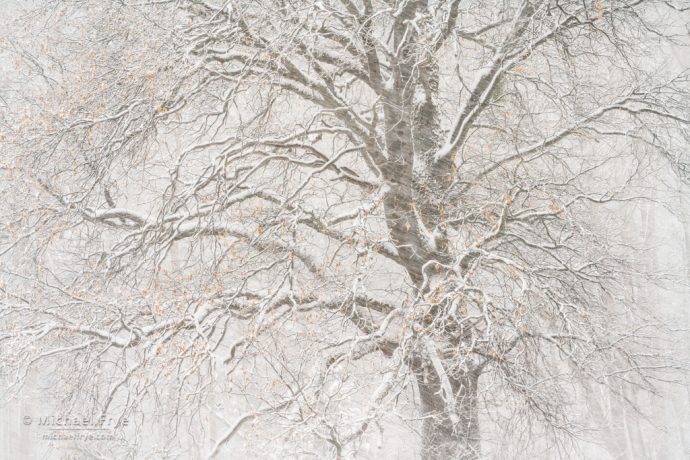Light and Weather
by Michael Frye | Apr 30, 2021 | Light and Weather

Poppies and foothill pines, Sierra Nevada, California. 91mm, 1/60 sec. at f/11, ISO 100.
We didn’t get any storms here in the Sierra between mid March and late April, and therefore no chance to photograph interesting weather. So what else could I photograph? What was happening that might provide opportunities to make a compelling photograph? Well it’s spring, so… flowers? That would seem logical.
But by California standards, it hasn’t been the greatest year for wildflowers. We had a dry winter, so the desert and semi-desert areas that sometimes display vast carpets of flowers have stayed brown. No “superbloom” (a word that seems to get applied to any above-average wildflower season these days).
Yet Claudia and I managed to find some beautiful patches flowers in the Sierra foothills. Around here, sometimes drier years produce good blooms, while in wet years the grasses can quickly grow tall enough to crowd out the flowers.
(more…)
by Michael Frye | Mar 28, 2021 | Light and Weather

Oak in a snowstorm, Yosemite. 253mm, 1/15 sec. at f/11, ISO 400.
In my last post I described how the most recent snowstorm led to some beautiful light and clouds – especially late in the day.
But when I arrived in the valley that morning it was still snowing. So I did what I always do: I asked myself, “What’s happening now?” In other words, what was interesting or unusual about that moment? What was unique and special in this place I’ve photographed so many times before?
(more…)
by Michael Frye | Mar 21, 2021 | Light and Weather

El Capitan emerging from clouds, Yosemite. 78mm, three bracketed frames, each at f/11, ISO 100, blended with Lightroom’s HDR Merge.
You can make a photograph without a camera, or lens, but you can’t make a photograph without light. The word “photograph” literally means “drawing with light.” Light is the essence of photography.
If light is our medium, it stands to reason that exceptional light has the potential to lead to exceptional photographs. It’s not a guarantee, of course; you still need to find a composition that works with that light, and execute the photograph technically. But the potential is there.
(more…)
by Michael Frye | Mar 14, 2021 | Light and Weather

Raven, trees, and crags, Yosemite
One of the most difficult tasks in landscape photography is deciding where to go. It seems simple, but it’s anything but, especially when the weather is changing quickly. Would I be better off staying put, or trying someplace else? Where (and when) will the light be most interesting?
It helps to know an area well, so you have a better idea about which spots might give you the best opportunities under different conditions. It also helps to know local weather patterns. And when cell service allows, I’ll use satellite, radar, and webcam images to see beyond my immediate field of view, and make a short-term weather prediction.
(more…)
by Michael Frye | Feb 21, 2021 | Light and Weather, Yosemite Photo Conditions

Three Brothers, Sentinel Rock, and the Merced River at sunrise, Yosemite. On Saturday morning the sun broke through the clouds just after sunrise to light the Three Brothers. 19mm, 1/20 sec. at f/11, ISO 100.
Aside from one big storm in late January, it’s been another dry winter here in central California. So any forecast for precipitation – even a small amount – piques my interest.
On Monday Yosemite Valley got two-tenths of an inch of rain, then another two-tenths early Saturday morning. That’s pretty meager, and often such small storms don’t add enough moisture to the atmosphere to generate any mist. But surprisingly, both of these small systems created lots of mist in the valley.
(more…)
by Michael Frye | Jan 31, 2021 | Light and Weather, Yosemite Photo Conditions

Snow-covered pines, Mariposa County, California. I found some snow-plastered trees in the fog as the storm was clearing.
Last week’s big storm played out mostly as predicted, dropping large amounts of rain and snow throughout much of California. The Yosemite area was right in the bullseye of the atmospheric river, but all of the Sierra Nevada got a healthy dose of rain and snow. Yosemite Valley’s rain gauge measured 6.67 inches. Other nearby areas received amounts ranging from four to eight inches, with one weather station just south of Yosemite recording slightly over ten inches.
Coastal mountains areas from Santa Cruz down to Santa Barbara reported impressive rainfall totals, with ten inches of rain in many gauges, and one spot along the Big Sur Coast, Chalk Peak, recording over 15 inches of rain in three days. A mudslide near Salinas damaged a number of buildings, and a section of Highway 1 south of Big Sur got washed out, but I think we were lucky to escape this big storm without more widespread damage.
(more…)














